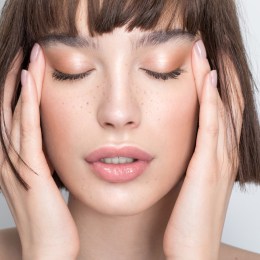If your clients are complaining of stubborn spots or sensitivities between treatments and despite being scrupulous about their prescriptive home skincare, maybe it’s time to quiz them about their, er, habits.
Their first reflex might be to blame the treatments and products you provide (not a great outcome) yet there are some very common traps we all fall into that create a breeding ground for bacteria and inflammation without even knowing it.
1. Too much of a good thing
No matter how impressed your clients are with your home prescriptive regime, the overwhelming odds are they are not going to buy everything from you. And, like all of us, they will cherry pick products that appeal in retail stores – including free samples – or try things they see recommended online.
But randomly mixing and matching skincare can counteract the effects of dedicated programs, or cause whole new problems if clients are using products that disagree with their skin or “combust” with prescribed products
2. Phone contact
Sometimes I look at my mobile phone screen and cringe. It’s greasy and cloudy with makeup and moisturisers et al underneath, as well as covered in finger smears. Imagine the disgustingness that thrives as a result!
It’s all evidence of dirt and bacteria, so imagine what that’s doing to the skin when you press it up against your cheek for long periods of time.
It’s not just mobiles, but good old-fashioned landline handpieces – especially those shared with others.
So keep those babies clean and try not to press them to your face. Hey, why not use ear pieces! Also good for brain health.
It’s not just phones – musical instruments, sunglasses or even your hand resting on your face (a reflex habit many people have) can cause spots to form.
Regularly clean objects used near your face – including your hands. Indeed, try not to unnecessarily touch your face.
3. Sweaty stuff
Most of us right now are steam cooking in humidity. It’s almost impossible not to get sweaty, however little you move about, but many times slicker than usual if you’re maintaining an active lifestyle, or just enjoying summer outdoors.
After you’ve had a vigorous walk or workout, or been outside in the heat, don’t let sweat dry on your skin – always wash off promptly, as accumulated sweat is a breeding ground for lurgies.
4. Don’t keep it too clean
Although it’s important to keep skin clean, washing it too often – and especially with overly harsh or unsuitable products – will strip its protective barrier and set it up for inflammation and/or infection.
Rule of thumb is cleansing morning and night, with gentle freshen-ups as needed during the day or before a special occasion.
5. Tread gently
It’s not just over-washing or using ill-suited products that can breach the barrier and otherwise aggravate delicate facial skin but the “tools” employed.
Scrubbing skin with a face washer, loofah or harsh exfoliant (especially one containing the dreaded, soon-to-be-banned plastic microbeads), no matter now “invigorating” it may feel, will cause significant irritation, and certainly exacerbate already compromised skin.
6. Blowing cold air
Air conditioning is a major factor in skin dryness, and when the skin is lacking in moisture it can go into oil production overload, which leads to blemishes.
Cold, artificial air isn’t the least bit friendly to your skin, so if you have to run it, place a humidifier in the room to bring the moisture back in.
In a work environment you may have no control over the matter, so keep a hydrating facial spray at the ready to replenish moisture levels and feel refreshed at regular intervals.
7. Avoid super-hot showers
As counterintuitive as it sounds in steamy weather, many of us still feel a whole lot fresher after a hot shower. But it’s just about the last thing your skin needs.
Hot water is incredibly drying, and dryness/dehydration can lead to breakouts as the skin goes into overdrive to replenish natural oils stripped by the heat. And overproduction of oil can lead to breakouts.
Rule of thumb: If skin is turning red, it’s time to end the shower or lower the temperature.
8. Hair’s the thing
The hair’s natural oils (especially if hair is prone to greasiness) can cause breakouts, as well as certain products (eg. too-rich conditioners, or haircare ingredients that react adversely with some skins).
Try to keep hair off the face and, if you have a fringe, make sure it’s clean, even if that means washing the fringe more often than the rest of your tresses.
9. Ditch dirty makeup applicators
Sponges and brushes used to apply makeup can be teeming with dead skin cells and bacteria, making those tools ripe for causing inflammation or infection: essentially, every time you apply makeup, you’re also applying nasties.
Be sure to wash your brushes at least once a week with mild shampoo and warm water or a designated cleanser.
Packets of makeup sponges are cheap as chips, so toss out the used ones after a week or less and start afresh.
10. Clean up before bed
After a tiring day at work, or a big night out, we can hardly wait to climb into our beds. It’s all too tempting to forgo a proper cleansing routine at night – indeed, not even take your makeup off (guilty!).
This one seemingly harmless act can undo a lot of progress of skin care, especially if being slack about night-time cleansing is not an isolated incident.
11. Beware what you keep close
Whether or not you’re diligent about washing your face before hitting the pillow, remember that pillowslips themselves can host a build-up of dirt and oil from the environment, as well as from skin and hair touching the fabric and transferring back to the skin (the effects amplified if you’re still wearing the day’s makeup). And let’s not forget sleep drool …
This cumulative cocktail of awfulness can clog pores and cause blemishes.
Regular washing/changeovers also applies to towels and cleansing sponges.
If you’re experiencing body acne, try to use a fresh towel after every shower.
12. Don’t spritz scent directly on skin
Perfume can cause skin irritation, and can exacerbate skins prone to breakouts.
Avoid spraying the décolletage and neck. Instead, apply perfume directly to the wrists and use a finger to dab on the neck (but be aware that perfume can also make the skin photo-sensitive and lead to pigmentation if exposed to UV rays).
If you wear essential oils, make sure the base oils used are non-comedogenic.
13. Don’t tan your hide
As well as dramatically accelerating photo-ageing and the risk of developing skin cancers, getting a tan can increase the chance of the skin erupting in spots, especially when combined with use of greasy sunscreens.
For those plagued by acne or persistent breakouts, getting a tan can seem like a panacea. In the short term, it dries up excess oils and conveniently browns inflamed areas.
But then comes the big backlash: the skin’s oil production goes into overdrive to “compensate” and UV exposure also increases skin cell production, leading to more dead skin cells and more opportunities for clogged pores.
DIET DEMONS
The food and drink we consume has a powerful impact on skin health. If a client’s breakouts persist when all other potential culprits have been ruled out, it’s definitely time to look at their diet.
Getting to the bottom of dietary issues, such as food allergies and intolerances, may require the expertise of a doctor or allied health specialist like a nutritionist or naturopath.
Eating too many high glycaemic (GI) foods can cause havoc with skin – think white breads, pasta and fast foods. These spike blood sugar, which can cause breakouts. Enjoy high GI fare as every-so-often treats, not dietary mainstays.
Cow’s milk and other dairy products such as cheese, cream, ice cream and yoghurt (the general exception is traditional Greek yoghurt) often contain growth hormones and other known inflammatory substances that can lead to clogged pores. They also cause digestive upsets in those who are lactose intolerant; and of course digestive issues often manifest on the skin.
Undiagnosed food allergies and intolerances can lead to an increase in breakouts, not to mention a wide variety of health issues. If after eating any food (particularly those that contain the top eight allergens – dairy, eggs, fish, shellfish, tree nuts, peanuts, wheat or soybeans) you experience breakouts, it may be the body’s way of communicating an allergy or intolerance. Abstain for a few weeks to see if your skin clears up, or seek out a specialist in the field to get to the bottom of the problem. Bonus: avoiding an allergen may result in other benefits such as less bloating and joint pain, even weight loss.




